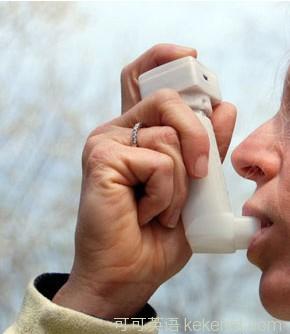
Science and Technolgy
科技
Medical devices
醫療設備
Inhaling information
有關吸入器的吸入信息
How to collect data on asthma while, at the same time, treating it
在處置哮喘的同時如何收集哮喘數據
IN 1985 and 1986 an epidemic of asthma hit Barcelona. The city's researchers first turned to the usual suspects, such as air pollution, pollen and mould. But a series of telephone interviews with the sufferers pointed to a much more precise cause. All the attacks had occurred by the harbour, and at times when ships were unloading soya beans. The cause was clear: soya-bean dust. So was the solution: the installation of filters on the harbour's silos.
1985年和1986年巴塞羅那哮喘病流行。這個城市的研究人員首先調查了一般的懷疑對象,如空氣污染、花粉和霉菌等。但從一連串對患者的電話隨訪中得出了一個更為確切原因。所有的哮喘發作都發生在港口,且都在貨船卸大豆的時候。原因很清楚:大豆灰塵。所以解決辦法就是:在港口的筒倉上安裝過濾器。
Asthma is one of the world's most common chronic diseases. It affects about 300m people (almost 5% of the population). Yet what triggers any given asthma attack is often unclear and, as a consequence, most asthmatics are not properly treated. Stories of success, like that of Barcelona, are rare.
哮喘是世界上最常見的慢性病之一。大約有3億人(接近人口的5%)患有哮喘。然而,人們往往并不清楚是什么誘發了任何特定哮喘的發作,其結果,大多數哮喘患者得不到妥善處置。象巴塞羅那這樣成功的故事是很罕見的。
Part of the reason for that lack of clarity is inadequate data on where and when attacks happen. But David Van Sickle, an epidemiologist and medical anthropologist who once worked for America's Centres for Disease Control and Prevention (CDC), has come up with a solution. This is to use the asthma inhalers carried around routinely by patients to record the time and location of symptoms as they happen.
缺乏確切了解的部分原因在于對哮喘在何時何地發作沒有足夠的數據。但是曾在美國疾病控制和預防中心(CDC)工作過的流行病學家和醫學人類學家大衛?凡?西科勒想出了一個解決方案。這個解決方案就是利用患者例行性隨身攜帶的哮喘吸入器來記錄他們的哮喘癥狀出現時的時間和位置。
To develop his idea, Dr Van Sickle left CDC and founded a company, Asthmapolis, which is based in Madison, Wisconsin. The result is Spiroscout, an inhaler with a built-in Global Positioning System locator and (in advanced models) a wireless link to the internet. Whenever someone uses the inhaler, it broadcasts the location and time to a central computer. Asthmapolis plots and analyses the data, and sends weekly reports to participating patients and their doctors summarising the observations and making recommendations.
為了開發他的想法,凡?西克爾博士離開美國疾病控制和預防中心并成立了一家公司,公司名為Asthmapolis,總部設在威斯康星州的麥迪遜市。其結果就是一款名為肺量測定法偵察員的吸入器問世,這款吸入器帶有內置的全球定位系統定位和(高級型)聯到互聯網的無線連接。每當有人使用吸入器時,吸入器就把位置和時間播報到中央計算機。Asthmapolis公司把播報來的數據繪制成圖并加以分析,每周向參與播報的患者以及他們的醫生發送報告,以便他們的醫生總結觀察并提出建議。
That is useful for the individuals involved, since it may illuminate patterns of which they were unaware (the proximity of a particular kind of crop, for example). It could also help doctors identify those patients whose asthma is not under proper control. Use of the inhaler more than a couple of times a month suggests there is something wrong, and that the patient's medication may need to be changed. Patients do not, however, always report such problems, and so do not get the right drugs. The big public gain, though, will come from pooling all the data from the inhalers, once they have been suitably anonymised. That will open the way for a much more detailed analysis of what is going on, and may allow the triggers to be identified and ranked in order of importance.
這對有關個人很有用,因為它可以闡釋未明的誘發哮喘模式(例如接近特定種類的農作物)。它還可以幫助醫生確定那些哮喘無法適當控制的病人。每月使用吸入器超過了一兩次的情況說明有問題存在,而病人的藥物可能需要更換了。然而,如果患者一直不報告這種問題,那么就無法得到正確的藥物。不過,最大公共收益將出自匯集所有吸入器播報的數據,這些數據從前被適當地隱藏了。這將開辟一種對發生的事情進行更詳細分析的方法,而且也可能讓哮喘的誘因得以識別并按照重要性的順序加以排列。
Over the past three years Dr Van Sickle has run two pilot studies to test the new tool. Both of these showed useful improvements in patients' management and understanding of their disease. They have also resulted in him questioning some longstanding theories about asthma, including the ideas that symptoms occur primarily at home and that the affliction is more prevalent in urban areas than rural ones. If those insights are confirmed, they will change the way asthma is managed.
過去三年來,凡?西克爾博士已經完成了兩次試點研究,以測試新的工具。兩次試點研究都顯示了對患者管理及疾病認識的有益改進。這兩次試點研究也讓凡?西克爾博士質疑一些長期存在的哮喘理論,包括癥狀主要發生在家里以及在城市地區比農村地區感染更盛行這樣的觀念。如果這些質疑結果得到證實,它們將改變控制哮喘的方法。
The next step, commercialisation, is planned for the autumn. With nearly 500,000 asthma-related hospital admissions every year in America alone (often involving cases where the disease could have been properly controlled by drugs, but was not), the market could be large. Alternatively, Dr Van Sickle's old friends at the CDC or some other medical-research agency might think the data sufficiently valuable to buy and distribute the things themselves. Either way, the upshot would be better lives for patients in the short term and, if all went well, a true understanding of the triggers of this debilitating and occasionally life-threatening condition.
下一步的商業化計劃在秋季進行。鑒于僅在美國每年就有近50萬與哮喘有關的病人入院治療(通常涉及的病例是該病可用藥物進行適當的控制,但不是所有病例),市場可能很大。另外,在美國疾病控制和預防中心或其它醫療研究機構工作的凡?西克爾博士的老朋友們可能會覺得這些數據有足夠的購買價值,并把它們用到自身的研究上。無論哪種方式,其結果都將會在短期內讓患者的生活更好,且一切順利的話,人們就會真正了解這種令人衰弱、有時危及生命的病癥的誘因。











